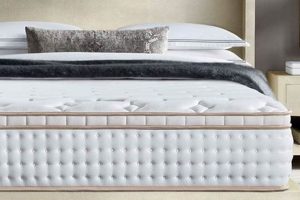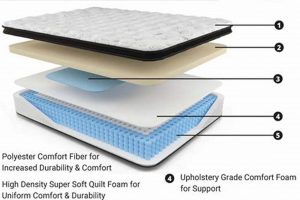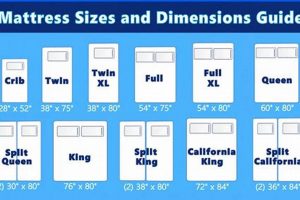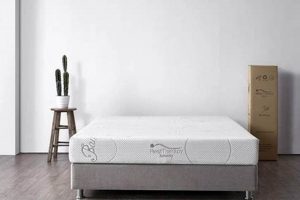Components designed to enhance the sleep surface, adding approximately two inches of material. These products typically consist of memory foam, latex, or down alternatives and are placed atop an existing mattress. For example, a worn or firmer mattress can be supplemented with this to introduce additional cushioning.
These additions offer a range of advantages, including improved pressure relief, enhanced comfort, and extended mattress lifespan. Historically, simpler forms of bedding enhancements existed, but modern manufacturing techniques allow for specific density and material combinations designed for targeted support. Their popularity stems from providing a cost-effective means to modify sleep surface characteristics without replacing the entire mattress.
The ensuing discussion will delve into the various materials utilized in their construction, explore their impact on sleep quality, and offer guidance on selecting the optimal product based on individual needs and preferences.
Guidance on Utilization
The subsequent points offer guidance to maximize the effectiveness and longevity when integrating this sleep surface enhancement into a bedding system.
Tip 1: Assess Existing Mattress Condition: Before acquisition, evaluate the underlying mattress. A significantly sagging or damaged mattress will not be adequately improved; instead, the topper will conform to the existing imperfections, negating potential benefits.
Tip 2: Consider Material Density: Denser materials, such as high-density memory foam, provide greater support and durability, suitable for individuals requiring more substantial pressure relief. Lower density options offer a softer feel but may compress more quickly over time.
Tip 3: Evaluate Heat Retention Properties: Certain materials, particularly some memory foams, are known to retain heat. Individuals prone to overheating during sleep should consider gel-infused or open-cell foam variants designed to promote airflow and dissipation of heat.
Tip 4: Secure Placement: Prevent slippage by using fitted sheets or a mattress protector designed to accommodate the added height. This maintains consistent positioning throughout the night and extends the product’s lifespan.
Tip 5: Implement Regular Cleaning: Refer to the manufacturer’s instructions for proper cleaning and maintenance. Vacuuming or spot-cleaning periodically helps remove dust mites and allergens, contributing to a healthier sleep environment.
Tip 6: Understand Support Requirements: Determine the level of support needed. Softer options are well-suited to side sleepers who require pressure relief around the shoulders and hips, while firmer choices cater to back and stomach sleepers.
By carefully considering these points, one can optimize the selection and utilization of this sleep surface enhancement, leading to improved sleep quality and extended mattress life.
The concluding section will synthesize the key findings presented and underscore the overall value in enhancing sleep surfaces.
1. Pressure Relief
Pressure relief, in the context of sleep surfaces, refers to the ability of a material to minimize concentrated forces exerted on specific areas of the body. When an individual lies on a traditional mattress, areas such as the shoulders, hips, and knees bear a disproportionate amount of weight, potentially leading to discomfort, restricted circulation, and disrupted sleep. A two-inch mattress topper can significantly alter this pressure distribution. For example, a memory foam topper conforms to the body’s contours, redistributing weight more evenly across the surface. This reduces localized stress on pressure points, mitigating pain and improving overall comfort.
The importance of pressure relief is particularly evident for individuals with pre-existing conditions such as arthritis, fibromyalgia, or back pain. These conditions often exacerbate sensitivity to pressure. Therefore, a topper that effectively alleviates these concentrated forces can promote restful sleep and reduce pain-related awakenings. Consider a patient recovering from hip surgery; the added cushioning and even weight distribution provided by a topper can significantly reduce post-operative discomfort and facilitate healing. Furthermore, the appropriate selection can prevent the development of pressure sores in individuals with limited mobility.
In conclusion, the effective implementation of pressure relief through a mattress topper is a practical approach to enhancing sleep comfort and mitigating pain. While material choice and density are crucial considerations, the ultimate goal remains the reduction of concentrated forces on the body. Failure to adequately address pressure points can negate the potential benefits, highlighting the need for informed selection and appropriate utilization to realize its benefits.
2. Material Density
Material density constitutes a critical factor influencing the performance characteristics of sleep surface enhancements. Its impact spans durability, support, and overall comfort, necessitating a comprehensive understanding for informed selection.
- Support and Conformability
Higher density materials, such as high-density memory foam, exhibit greater resistance to compression. This translates to enhanced support for the user, preventing excessive sinking and promoting proper spinal alignment. Conversely, lower density materials conform more readily to the body’s contours, providing a softer feel and enhanced pressure relief. The selection depends on individual preferences and requirements.
- Durability and Longevity
Density directly correlates with the lifespan. Higher density options possess greater resistance to wear and tear, retaining their shape and supportiveness for longer durations. Lower density materials, while initially comfortable, are more prone to compression and degradation over time, leading to reduced performance and the need for premature replacement.
- Heat Retention Properties
Generally, denser materials tend to retain more heat compared to their less dense counterparts. High-density memory foam, for example, can trap body heat, potentially leading to discomfort for individuals who tend to overheat during sleep. This necessitates consideration of alternative materials or designs that incorporate cooling technologies.
- Weight and Handling
Higher density translates to increased weight. A dense mattress topper can be more challenging to handle, move, and clean. Lighter, lower density options offer greater ease of use, but may compromise on support and durability. Practical considerations regarding handling should therefore be taken into account.
These facets demonstrate the multifaceted relationship between material density and the functional attributes of two-inch mattress toppers. Evaluating these factors in the context of individual needs and preferences is paramount for selecting a product that effectively enhances sleep quality and provides lasting comfort. The material density is a determining factor of quality and should be considered before all else.
3. Heat Dissipation
Heat dissipation represents a critical performance parameter for sleep surfaces, particularly when considering two-inch mattress toppers. The inherent properties of many common topper materials, such as memory foam, tend to impede airflow and trap body heat, leading to elevated skin temperatures and potential sleep disturbances. The two-inch thickness further exacerbates this issue by adding an insulating layer on top of the existing mattress. Consequently, effective heat dissipation mechanisms become essential for maintaining a comfortable sleep environment. Failure to manage temperature can result in increased tossing and turning, reduced time spent in deeper, restorative sleep stages, and a general perception of discomfort. For example, an individual residing in a warmer climate may find a non-breathable topper unbearable, leading to chronic sleep deprivation. Conversely, a topper with enhanced ventilation or cooling technologies can mitigate these effects, promoting a more restful and temperature-neutral sleep experience.
Material selection plays a pivotal role in optimizing heat dissipation. Open-cell memory foam, for instance, features a more porous structure compared to traditional memory foam, facilitating greater airflow and reducing heat retention. Gel-infused memory foam incorporates gel particles designed to absorb and dissipate heat, offering a further cooling effect. Latex, both natural and synthetic, exhibits inherent breathability due to its open-cell structure, making it a suitable option for individuals concerned about overheating. Design features, such as ventilation channels or convoluted surfaces, can also enhance airflow and promote heat exchange. Consider the case of a long-distance truck driver, spending extended periods sleeping in their truck’s sleeper berth; a topper incorporating these features can significantly improve sleep quality and reduce fatigue by maintaining a comfortable temperature throughout the night. These design improvements are crucial for managing the thermal impact on the sleep surface.
In summary, efficient heat dissipation is a vital consideration when selecting a two-inch mattress topper. The inherent properties of many topper materials contribute to heat retention, potentially compromising sleep quality. However, through careful material selection, innovative design features, and a focus on breathability, the negative thermal effects can be mitigated. The implementation of cooling technologies ensures the selected enhancement not only adds comfort but also contributes to a temperature-regulated, restful sleep environment. Understanding the science of thermal management is crucial for selecting a sleep solution.
4. Spinal Alignment
Maintaining proper spinal alignment during sleep is paramount for musculoskeletal health and overall well-being. The sleep surface plays a critical role in supporting the spine’s natural curvature, and two-inch mattress toppers can significantly influence this alignment, either positively or negatively, depending on their construction and material properties.
- Support Distribution and Posture
A topper’s ability to distribute body weight evenly is fundamental to spinal alignment. An inadequate topper may allow certain areas of the body, such as the hips or shoulders, to sink excessively, leading to spinal curvature. Conversely, a suitably supportive topper fills gaps between the body and the mattress, promoting a neutral spinal position. For example, a side sleeper requires adequate support beneath the waist to prevent the spine from sagging, while a back sleeper needs support for the lumbar region. Proper support is critical for posture.
- Material Firmness and Contouring
The firmness of the topper material dictates its interaction with the spine. A topper that is too soft may lack the necessary support, while a topper that is too firm may not conform to the body’s contours. Memory foam toppers, for instance, are known for their contouring abilities, which can help maintain spinal alignment by cradling the body and reducing pressure points. A person with scoliosis, for instance, might benefit from the customized support of a memory foam topper.
- Layering and Bedding System Integration
The effectiveness of a two-inch topper in promoting spinal alignment is intrinsically linked to the underlying mattress and the overall bedding system. A topper cannot fully compensate for a sagging or unsupportive mattress. Instead, the topper should complement the mattress, enhancing its existing support characteristics. Consider a scenario where an individual adds a soft topper to an already soft mattress; the resulting lack of support can exacerbate spinal misalignment. A properly integrated sleep surface is essential to healthy rest.
- Individual Sleep Position Considerations
Optimal spinal alignment differs based on individual sleep positions. Side sleepers generally require a softer topper to accommodate the shoulders and hips, while back and stomach sleepers typically benefit from a firmer topper that prevents excessive sinking. Recognizing these positional variations is critical for selecting a topper that supports the spine in its most natural configuration. Consider someone who switches sleep positions throughout the night and their need for a surface offering varied support.
The selection of a two-inch mattress topper to enhance spinal alignment necessitates a careful assessment of individual needs, sleep position, and the characteristics of the underlying mattress. Proper integration of these factors will result in a sleep surface that promotes optimal spinal health and overall well-being, contributing to a more comfortable and restful sleep experience. This is crucial for long term health.
5. Motion Isolation
Motion isolation, pertaining to sleep surfaces, denotes the degree to which movement on one area of the mattress is localized and does not propagate to other areas. This is particularly relevant in shared sleeping environments, where the movements of one individual can disrupt the sleep of another. Two-inch mattress toppers, dependent on their material composition and construction, can significantly influence the extent of motion isolation.
- Material Damping Properties
Materials such as memory foam and latex possess inherent damping properties, meaning they absorb and dissipate energy rather than transmitting it. A two-inch topper constructed from these materials effectively reduces the transfer of motion across the sleep surface. For instance, when one partner turns over in bed, the compression and decompression of the foam are localized, minimizing disturbance to the other partner’s side. This is because these materials don’t have springs to transfer the motion throughout. The more damping capabilities, the more isolating the component.
- Thickness and Density Considerations
While the two-inch thickness contributes to overall comfort, the density of the topper material further influences motion isolation. Higher density materials, while providing greater support, may also exhibit slightly better motion isolation due to their increased mass and reduced tendency to vibrate. A denser memory foam topper, for example, would be more effective at preventing motion transfer compared to a lower density option of the same thickness. Heavier components have less ability to transfer movement.
- Compatibility with Underlying Mattress
The motion isolation capabilities of a two-inch topper are intrinsically linked to the properties of the underlying mattress. A topper cannot fully compensate for a mattress with poor motion isolation characteristics, such as an innerspring mattress with interconnected coils. In such cases, motion will still propagate through the spring system, albeit to a lesser extent. For optimal motion isolation, the topper should be paired with a mattress that independently minimizes motion transfer. An integrated, supportive mattress allows the topper to further isolate the movement.
The effectiveness of a two-inch mattress topper in providing motion isolation is contingent upon material selection, density considerations, and compatibility with the underlying mattress. When strategically implemented, such enhancements can significantly reduce sleep disturbances in shared sleeping environments, promoting more restful and uninterrupted sleep. Evaluating needs and researching the materials helps with this component’s quality and effectiveness.
6. Durability
The longevity of a two-inch mattress topper is directly contingent upon the materials used in its construction and the manufacturing processes employed. Lower-quality materials, such as low-density memory foam or inferior latex blends, degrade more rapidly, resulting in a shorter lifespan for the product. This degradation manifests as reduced support, compression, and an overall loss of the topper’s intended functionality. Conversely, high-density memory foam, natural latex, and rigorously tested synthetic materials exhibit greater resistance to wear and tear, extending the usable life of the topper. For example, a topper constructed with CertiPUR-US certified foam is likely to outlast a comparable product made from uncertified materials due to stringent quality control standards.
Durability considerations extend beyond material selection to encompass the topper’s construction. Reinforced edges, for instance, prevent sagging and maintain the topper’s shape over time. Protective covers, particularly those that are waterproof and hypoallergenic, shield the underlying materials from spills, stains, and allergens, thereby prolonging their integrity. Proper care and maintenance, including regular cleaning and the use of a mattress protector, further contribute to the topper’s durability. Failure to adhere to these maintenance practices accelerates wear and tear, diminishing the product’s lifespan. An owner who frequently washes and dries their topper improperly can severely shorten its service life and eliminate protective compounds that could increase its longevity.
In summation, the durability of a two-inch mattress topper is a critical factor determining its long-term value and performance. Selecting a topper constructed from high-quality materials, coupled with proper care and maintenance, maximizes its lifespan and ensures sustained comfort and support. Disregarding these aspects can lead to premature degradation, necessitating replacement and negating the initial cost savings associated with purchasing a less durable product. This underlines the importance of informed decision-making based on factors beyond initial price.
7. Cost-Effectiveness
The economic viability of a two-inch mattress topper as a bedding solution hinges on its ability to deliver a discernible improvement in sleep quality and mattress lifespan relative to its purchase price. Assessing cost-effectiveness requires a comprehensive evaluation of both initial costs and long-term benefits.
- Extending Mattress Lifespan
A primary cost-saving benefit stems from the potential to prolong the life of an existing mattress. By providing an additional layer of support and cushioning, the topper absorbs a portion of the wear and tear that would otherwise be concentrated on the underlying mattress. For instance, a mattress exhibiting minor sagging or discomfort can often be rejuvenated with a topper, delaying the need for a costly mattress replacement. This extension of functional life represents a direct economic advantage.
- Alternative to Mattress Replacement
In many instances, the acquisition of a two-inch mattress topper presents a more economical alternative to purchasing a new mattress. The cost of a quality topper is typically a fraction of the price of a comparable mattress. Individuals experiencing discomfort due to a too-firm or slightly worn mattress may find that a topper provides the necessary adjustment without incurring the expense of a full replacement. This cost differential makes toppers attractive for budget-conscious consumers.
- Improved Sleep Quality and Health Benefits
Enhanced sleep quality can yield indirect, yet significant, economic benefits. Improved rest can lead to increased productivity, reduced healthcare costs associated with sleep deprivation, and improved overall well-being. A topper that effectively addresses pressure points, promotes spinal alignment, or regulates temperature can contribute to these positive outcomes, making it a worthwhile investment from a holistic perspective. Consider the reduced healthcare expenses of a rested body that can function throughout the day to its fullest potential.
- Material Durability and Replacement Frequency
The long-term cost-effectiveness is influenced by the topper’s durability and expected lifespan. Lower-quality toppers may require more frequent replacement, negating any initial cost savings. Selecting a topper constructed from durable materials, such as high-density memory foam or natural latex, ensures a longer service life and a better return on investment. The importance of assessing materials before costs, when trying to determine value for money.
In summation, the cost-effectiveness of a two-inch mattress topper is a multifaceted consideration. While the initial purchase price is a factor, the potential for extending mattress life, averting mattress replacement, improving sleep quality, and the topper’s inherent durability all contribute to its overall economic value. Thoroughly evaluating these aspects enables informed decision-making and maximizes the return on investment.
Frequently Asked Questions about 2 Inch Mattress Toppers
The following section addresses common inquiries regarding the selection, utilization, and maintenance of two-inch mattress toppers. The information is presented to clarify misconceptions and provide practical guidance.
Question 1: Does a two-inch mattress topper adequately address significant mattress sagging?
A two-inch mattress topper is designed to enhance comfort and provide moderate support. It is not a substitute for a structurally sound mattress. Significant sagging necessitates mattress replacement, as the topper will conform to the existing imperfections.
Question 2: What is the optimal material density for a two-inch mattress topper?
The ideal density is contingent on individual needs and preferences. Higher density materials offer greater support and durability, while lower density options provide a softer feel. Body weight and sleep position should inform this selection.
Question 3: How frequently should a two-inch mattress topper be cleaned?
Regular cleaning, typically every one to three months, is recommended. Vacuuming removes surface debris and dust mites. Spot cleaning addresses stains. Adherence to the manufacturer’s instructions is crucial.
Question 4: Can a two-inch mattress topper resolve chronic back pain?
While a topper can alleviate pressure points and improve spinal alignment, it is not a guaranteed solution for chronic back pain. Consult a healthcare professional for persistent pain issues. A topper is only one component of a larger, specialized treatment plan.
Question 5: Are all two-inch mattress toppers compatible with adjustable bed frames?
Most two-inch mattress toppers are compatible with adjustable bed frames due to their flexibility. However, confirm compatibility with the manufacturer prior to purchase.
Question 6: How does topper thickness affect the choice of fitted sheets?
The added two inches of height requires fitted sheets with deeper pockets to ensure a secure fit and prevent slippage.
In summary, the effectiveness of a two-inch mattress topper is dependent on careful selection, proper maintenance, and realistic expectations. It is a valuable tool for enhancing comfort and extending mattress life, but not a universal solution for all sleep-related issues.
The subsequent section will summarize the preceding points, reiterating benefits and considerations.
Conclusion
The preceding analysis has explored the multifaceted aspects of 2 inch mattress toppers. Key considerations include material density, heat dissipation, spinal alignment support, motion isolation capabilities, durability, and overall cost-effectiveness. Selecting the optimal product necessitates a thorough assessment of individual needs and a realistic understanding of the enhancement’s capabilities relative to an existing sleep system.
Ultimately, 2 inch mattress toppers represent a targeted intervention aimed at improving sleep quality and extending mattress life. Prudent selection and diligent maintenance practices are essential for realizing the full potential of this sleep surface enhancement. Future research should investigate the long-term health implications of topper usage and further refine material technologies to optimize comfort and support.


![Buy Best 8 Inch Tri Fold Queen Mattress [Deals] Organic & Natural Mattress Buyer’s Guide: Non-Toxic Sleep Solutions Buy Best 8 Inch Tri Fold Queen Mattress [Deals] | Organic & Natural Mattress Buyer’s Guide: Non-Toxic Sleep Solutions](https://mattressworldpa.com/wp-content/uploads/2025/07/th-3717-300x200.jpg)
![Best 8 Inch Foam Mattress For [Sleep Style] & Budget! Organic & Natural Mattress Buyer’s Guide: Non-Toxic Sleep Solutions Best 8 Inch Foam Mattress For [Sleep Style] & Budget! | Organic & Natural Mattress Buyer’s Guide: Non-Toxic Sleep Solutions](https://mattressworldpa.com/wp-content/uploads/2025/07/th-3716-300x200.jpg)



